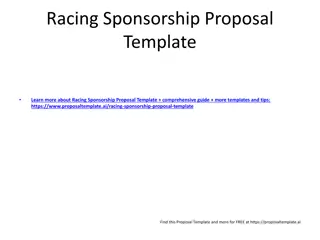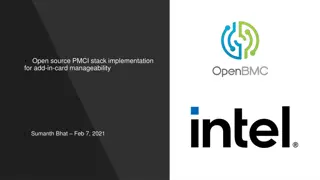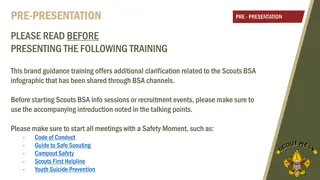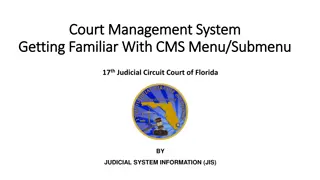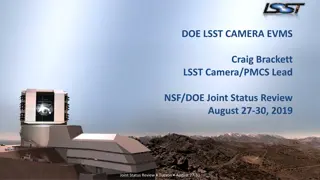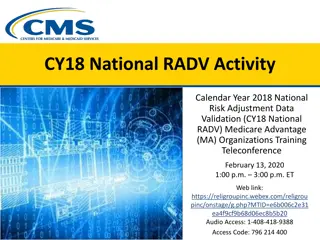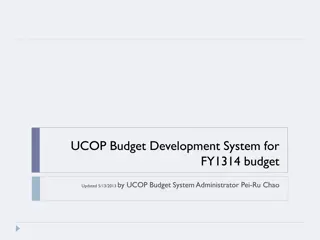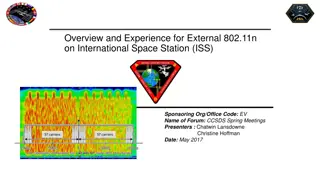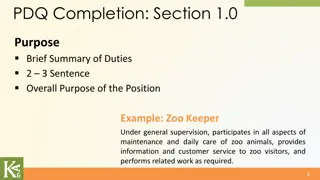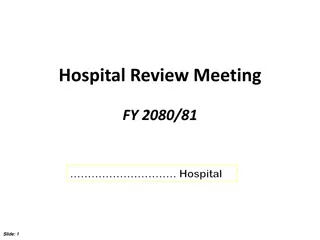NB overview
The document explores the status of VLP NB operation in the 6 GHz band in Europe, focusing on ETSI 6 GHz NB rules and EN 303.687 overview. It delves into spectrum sharing for NB/Wi-Fi coexistence, LBT requirements, and proposed access rules. Additionally, it discusses Wi-Fi/BT coexistence in the 2.4 GHz band, highlighting mechanisms like Forty MHz Intolerant signaling and antenna isolation for improved coexistence.
Download Presentation

Please find below an Image/Link to download the presentation.
The content on the website is provided AS IS for your information and personal use only. It may not be sold, licensed, or shared on other websites without obtaining consent from the author.If you encounter any issues during the download, it is possible that the publisher has removed the file from their server.
You are allowed to download the files provided on this website for personal or commercial use, subject to the condition that they are used lawfully. All files are the property of their respective owners.
The content on the website is provided AS IS for your information and personal use only. It may not be sold, licensed, or shared on other websites without obtaining consent from the author.
E N D
Presentation Transcript
March 2023 doc: IEEE 802.11-23/453r0 NB overview Author: Name Affiliation Address Email Utrecht, mwentink qti qualcomm Menzo Wentink Qualcomm The Netherlands Slide 1 Submission Menzo Wentink, Qualcomm
March 2023 doc: IEEE 802.11-23/453r0 Introduction Slide 2 Submission Menzo Wentink, Qualcomm
March 2023 doc: IEEE 802.11-23/453r0 ETSI 6 GHz NB status In the 6 GHz band in Europe, VLP NB operation can use a higher PSD when more than 15 hops are used NB is defined as < 20 MHz transmit BW max 10 dBm/MHz for VLP NB vs max 1 dBm/MHz for VLP WB, max 14 dBm EIRP the EC also requires adequate spectrum sharing NB/Wi-Fi coexistence for 6 GHz was discussed in ETSI BRAN in ~2021 (EN 303 687) EN 303 687 is currently in the final stages of national review (ENAP) and EC review EN 303 687 requires LBT with a 20 MHz CCA for NB (and for Wi-Fi, LAA, NR-U, etc.) in combination with either Frame Based access (FBE) or Load Based access (LBE) FBE has a short CCA at fixed periodic times ('frames'), immediately preceding the transmission LBE is the equivalent of Wi-Fi EDCA Detect and Avoid (DAA/eDAA) was also discussed for NB but the response time was considered to be too long by some, and DAA might also trigger on other NB transmissions, which complicates NB-to-NB coexistence new proposals are expected for the next revision of the 6 GHz standard The VLP NB access rules in EN 303 687 are in summarized in the next slides Slide 3 Submission Menzo Wentink, Qualcomm
March 2023 doc: IEEE 802.11-23/453r0 EN 303 687 overview Slide 4 Submission Menzo Wentink, Qualcomm
March 2023 doc: IEEE 802.11-23/453r0 VLP NB rules in EN 303 687 Slide 5 Submission Menzo Wentink, Qualcomm
March 2023 doc: IEEE 802.11-23/453r0 BT coex in 2.4 GHz In 2.4 GHz, Wi-Fi/BT coexistence is partly achieved through the 'Forty MHz Intolerant' signaling defined in IEEE 802.11: The Forty MHz Intolerant signaling effectively forces all Wi-Fi to operate in 20 MHz when BT is co-located in a nearby Wi-Fi device a kind of Frequency Division Multiple Access (FDMA), by reducing the Wi-Fi operating bandwidth Wi-Fi is limited to 20 MHz and BT uses the remaining 60 MHz of the 2.4 GHz band for non-co-location operation, Wi-Fi also sometimes uses Time Division Multiple Access (TDMA) Slide 6 Submission Menzo Wentink, Qualcomm
March 2023 doc: IEEE 802.11-23/453r0 Co-located BT coex in 2.4 GHz When BT is co-located with Wi-Fi in the same device, complex coexistence mechanisms are implemented to ensure that the two technologies coexist well antenna isolation helps, but certainly without isolation, the Wi-Fi module has to use dynamic switching in and out of power save to avoid receptions at a time when the BT module is transmitting (TDMA) these are complex mechanisms, which have to be tailored for specific BT traffic patterns Slide 7 Submission Menzo Wentink, Qualcomm
March 2023 doc: IEEE 802.11-23/453r0 Overview of some NB channel access mechanisms Slide 8 Submission Menzo Wentink, Qualcomm
March 2023 doc: IEEE 802.11-23/453r0 eDAA Enhanced Detect and Avoid (eDAA) was proposed in ETSI BRAN as an enhanced version of DAA as defined in EN 300 328 (2.4 GHz), but with 0.5 s between CCAs evacuation in 20 MHz blocks two options for channel restoration: option 1: after 0.5 s when CCA is clear option 2: after 2.5 s without CCA (exponentially increasing) Slide 9 Submission Menzo Wentink, Qualcomm
March 2023 doc: IEEE 802.11-23/453r0 eDAA with CCA sweep eDAA can use an offline sweep to determine a spectrum map the sweep can be in one go or in portions during the 0.5 s between CCA checks every 0.5 s eDAA would analyze the spectrum map and disable 20 MHz segments where WB is detected in the sims, WB is considered to be present when >60% of a 20 MHz segment has a CCA busy the use of a spectrum map avoids any issues between NB links, but it does not appear to be an improvement for coexistence with WB Slide 10 Submission Menzo Wentink, Qualcomm
March 2023 doc: IEEE 802.11-23/453r0 LBT for NB Listen before Talk (LBT) for NB uses a CCA before every hop LBT for NB could be based on channel access for Frame Based Equipment (FBE) With some extra measures, the CCA time could be relatively short see next slide on LBT with CCA trigger without extra measures, the CCA time should be in the order of 187 us, so that access will not happen during Wi-Fi backoffs and SIFS intervals the high frequency of the NB CCAs makes it necessary that the CCA time is not too short but a long CCA time is difficult to integrate into the existing NB architecture Slide 11 Submission Menzo Wentink, Qualcomm
March 2023 doc: IEEE 802.11-23/453r0 LBT with CCA trigger CCA trigger uses a short CCA (e.g. 7 us) before every hop, but disables a 20 MHz segment when multiple consecutive CCA-busies ('triggers') occur in the segment, until several consecutive CCA-idles occur in the segment the NB node keeps a tally of consecutive CCA busy events ('triggers') in each segment that it hops in: +1 when the CCA before a hop inside the segment is busy 1 when the CCA before a hop inside the segment is idle when the number of triggers 3, the segment is blocked, otherwise it can be used (provided the CCA before hops in that segment is idle) the trigger count is capped between 0 and 6 Slide 12 Submission Menzo Wentink, Qualcomm
March 2023 doc: IEEE 802.11-23/453r0 Simulations Slide 13 Submission Menzo Wentink, Qualcomm
March 2023 doc: IEEE 802.11-23/453r0 Simulation parameters Wi-Fi settings Tx power: 23 dBm at AP (LPI), 21 dBm at STA (LPI) packet size: 2 ms downlink traffic, full buffer channel width: 160 MHz max bitrate: 2402 Mbps at HE MCS 11, 160 MHz, 2x996-tone RU, Nss = 2, 800 ns GI frame exchange: RTS/CTS/A-MPDU/BA start time: 5 s NB settings Tx power: 14 dBm (VLP) dwell time: 625 us (BT LE) duty cycle 68% hop width: 4 MHz (30 Mbps max PHY rate, Nss = 1) hopping pattern: random, 125 hops (500 MHz total) eDAA settings: 0.5 s between CCAs, evacuation in 20 MHz blocks, two options for channel restoration: Option 1: after 0.5 when CCA is clear Option 2: after 2.5 s without CCA (exponentially increasing) eDAA CCA sweep settings: 0.5 s between spectrum scan evaluations, 100 MHz per sweep, 5 sweeps per 0.5 s, 60% occupation threshold per 20 MHz segment LBT settings: 187 us CCA before each hop, FBE CCA trigger settings: 7 us CCA before each hop, FBE, trigger threshold 3, 20 MHz segments start time at ~0.5 s intervals starting at 0 s Channel model AWGN channel with a breakpoint at 5 m pathloss = 40.05 + 20log10(f/2.4) + 20log10(min(d, b)) + (d > b) * (35log10(d/b)) where f = 5.18 GHz, d = distance, b = breakpoint = 5 m Slide 14 Submission Menzo Wentink, Qualcomm
March 2023 doc: IEEE 802.11-23/453r0 Wi-Fi/NB coexistence setup 15 AP 10 LPI Wi-Fi link downlink traffic y (m) 5 VLP NB links VLP NB links 0 STA -5 -5 0 5 10 15 x (m) Slide 15 Submission Menzo Wentink, Qualcomm
March 2023 doc: IEEE 802.11-23/453r0 Wi-Fi/NB (no NB) Throughput per node (Mbps) Aggregate throughput (Mbps) 3000 3000 Aggregate throughput(Mbps) 2500 2500 Throughput (Mbps) 2000 2000 1500 1500 1000 1000 500 500 0 0 0 5 10 15 20 0 5 10 15 20 Time (s) Time (s) Wi-Fi starts at 5 s Number of Active Hops Access delay (ms) 25 120 Number of Active Hops 20 Access delay (ms) 100 15 80 60 10 40 this plot is not defined for this experiment 5 20 0 0 0 5 10 15 20 0 5 10 15 20 Time (s) Time (s) nb_r412 Slide 16 Submission Menzo Wentink, Qualcomm
March 2023 doc: IEEE 802.11-23/453r0 Wi-Fi/NB (eDAA option 1) 1 s initial ramp- up time at Wi-Fi Degraded throughput at Wi-Fi Wi-Fi starts at 5 s Significant latency at both Wi-Fi and NB eDAA hop evacuation is uneven and unstable NB starts at 0.5 s intervals nb_r412 Slide 17 Submission Menzo Wentink, Qualcomm
March 2023 doc: IEEE 802.11-23/453r0 Wi-Fi/NB (eDAA option 2) 1 s initial ramp- up time at Wi-Fi An oscillation occurs because the NB nodes see the Wi-Fi signal at roughly the same time, and therefore the hops also return at roughly the same time, 2.5 s later. 1 s gaps The oscillation slowly fades within a few minutes, but Wi-Fi throughput remains degraded. 2.5 s gap repetitition time Wi-Fi starts at 5 s Significant latency at both Wi-Fi and NB eDAA hop evacuation is uneven and unstable NB starts at 0.5 s intervals nb_r294b Slide 18 Submission Menzo Wentink, Qualcomm
March 2023 doc: IEEE 802.11-23/453r0 Wi-Fi/NB (eDAA option 1, CCA sweep) long ramp-up time at Wi-Fi Degraded throughput at Wi-Fi Wi-Fi starts at 5 s Significant latency at both Wi-Fi and NB eDAA hop evacuation is uneven and unstable NB starts at 0.5 s intervals nb_r752 Slide 19 Submission Menzo Wentink, Qualcomm
March 2023 doc: IEEE 802.11-23/453r0 Wi-Fi/NB (LBT 187 us CCA) Immediate ramp- up at Wi-Fi Wi-Fi has stable throughput when NB uses LBT with a 187 us CCA Both NB and Wi-Fi have low latency (This plot is not defined for LBT) nb_r412 Slide 20 Submission Menzo Wentink, Qualcomm
March 2023 doc: IEEE 802.11-23/453r0 Wi-Fi/NB (LBT 70 us CCA) Immediate ramp- up at Wi-Fi but much reduced throughput at Wi-Fi Both NB and Wi-Fi have low latency (This plot is not defined for LBT) nb_r412g Slide 21 Submission Menzo Wentink, Qualcomm
March 2023 doc: IEEE 802.11-23/453r0 Wi-Fi/NB (LBT 7 us CCA) Immediate ramp- up at Wi-Fi but much reduced throughput at Wi-Fi Both NB and Wi-Fi have low latency (This plot is not defined for LBT) nb_r412g Slide 22 Submission Menzo Wentink, Qualcomm
March 2023 doc: IEEE 802.11-23/453r0 Wi-Fi/NB (LBT 7 us, CCA trigger) Immediate ramp- up at Wi-Fi Wi-Fi has stable throughput when NB uses LBT CCA trigger with 3 triggers per 20 MHz segment, with a 7 us CCA Both NB and Wi-Fi have low latency nb_r480 Slide 23 Submission Menzo Wentink, Qualcomm
March 2023 doc: IEEE 802.11-23/453r0 Conclusions ETSI BRAN requires LBT with a 20 MHz CCA for NB operation in the 6 GHz band (EN 303 687) Existing BT coexistence in the 2.4 GHz band builds on reducing the Wi-Fi bandwidth and the use of TDMA by Wi-Fi the current experience is not very positive, from the Wi-Fi perspective at least eDAA appears to be inadequate as a coexistence mechanism, for Wi-Fi/NB and possibly also for NB/NB coexistence eDAA can have a long response time and exhibits oscillatory behavior channel evacuation might be incomplete due to eDAA CCAs not seeing Wi-Fi traffic (because Wi-Fi also defers for NB using LBT) eDAA might not necessarily coexist well with itself, because the penalty for an inter-hop collisions (CCA-busy) is high even when the hop collision probability is relatively low LBT appears to work quite well low latency and stable throughput, both for Wi-Fi and NB for NB the LBT could be based on the LBT for Frame Based Equipment (FBE) as defined in EN 303 687 LBT for NB works well because the penalty for a CCA-busy is just one hop, and the next hop, which is likely elsewhere in the spectrum, might have a CCA-idle a short CCA is possible in combination with a trigger mechanism that disables 20 MHz segments (CCA trigger) Slide 24 Submission Menzo Wentink, Qualcomm
March 2023 doc: IEEE 802.11-23/453r0 References BRAN(21)109h004r2_EN_303_687_NB_Proposals_for_DAA_Optimisation BRAN(21)109h007_NB_coexistence_with_WB_in_6_GHz ETSI EN 300 328 (2.4 GHz) ETSI EN 301 893 (5 GHz) ETSI EN 303 687 (6 GHz) Slide 25 Submission Menzo Wentink, Qualcomm
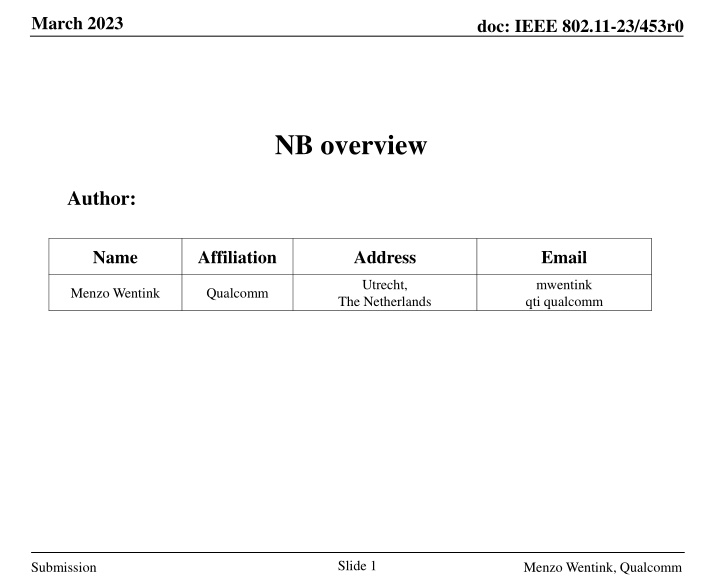

![❤[READ]❤ Deep Space Craft: An Overview of Interplanetary Flight (Springer Praxis](/thumb/21511/read-deep-space-craft-an-overview-of-interplanetary-flight-springer-praxis.jpg)



